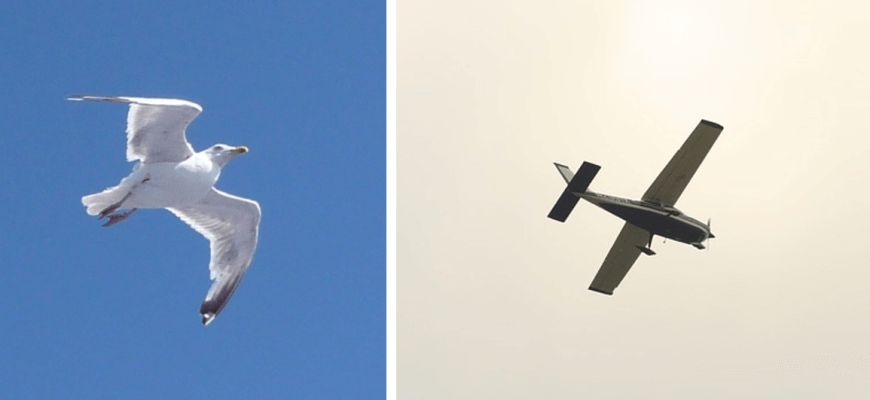At this point, you have probably read some of our articles about Biomimetic research and products. We hope that we could give you an idea of the exciting world of Biomimetics and its potential which fascinates us so much!
But I would like to pause for a moment here and tackle a reasonable question which can easily arise: Biomimetics is a modern branch of research which results in ‘interesting features, worth to be researched further’ and starting points for product development … but is it really part of our daily life?
Biomimetics IS a very young field of research, which is only just starting to become popular and recognized by the research community.
BUT: each and every one of us encounters biomimetic products everyday – we just do not always recognize them as such! I’d like to reveal to you three biomimetic products with the guarantee that you use or see at least one every day.
Aeroplanes
I think there is no denying that planes are part of everyone’s daily life – not only for flying to our holiday destination or business trips but also for cargo logistics. In my opinion, planes are the most obvious but also the most neglected biomimetic product. Already Leonardo da Vinci – as a pioneer in art, sculpting and natural science – observed and studied the flight movement of birds to construct a device for flying. Even though he was not reaching his goal completely, his studies were an important base for later developments of creative and more or less successful flight vehicles (e.g. by Otto Lilienthal or the Wright brothers). Planes are a wonderful example to explain what Biomimetics is: it demonstrates on the one hand the obvious similarities between the technical object and the biological concept generator – such as the aerodynamic shape of the flying object. On the other hand it reveals the necessity of abstracting the natural system and making necessary changes…. or did you ever observe a plane flapping its wings..? [1, 2]
Velcro®
Probably the most successful biomimetic product which is also not always recognized as such is Velcro® – or in German: Klettverschluss. It is quite ironic that this product can be mistaken as not being biomimetic, as it even carries its biological inspiration in its name (at least in German). Besides being pretty useful and almost ridiculously simple in its working principle, Velcro® has a major feature, promoting its huge success and making a marketing strategy almost completely unnecessary: its mechanism has a unique sound which all of you should know (and hear in your head right know). I think it would be a waste of your precious time to explain the working principle of Velcro® at this point… if you still are not sure what I am writing about: go for a walk with your dog or your woollen pullover in the forest and climb a little bit through the bushes. What you find in your sweater or your dog’s fur later and spent hours to remove will give you a clear idea of the Velcro® mechanism! [3].
Form-optimized structures in technology and architecture
Natural structures such as tree stems, branches or thorns are optimized in their design to avoid stress peaks. Already in their growth process they are subject to different loads which influence their structural development from the beginning. This is the main difference between support structures from nature and technology (including architecture): in nature things grow in response to their mechanical requirements – in technology we plan and construct having a specific load case (mostly the maximum + a safety factor) in mind without an adaptability of our final product (as this is really challenging with our state-of-the art materials).
Still –optimized structures in biology have been studied extensively and are actually implemented more frequently in engineering as you might think.
One famous example is the optimization of technical components via specific simulation tools such as ‘Computer aided optimization’ or ‘Soft Kill Option’ developed by the biomechanical lab of the IAM/ KIT (Prof. Dr. Claus Mattheck) [4]. With the help of these tools, load-adapted growth and development – so called ‘biological design’ – can be applied in the construction of technical elements. For example in the process of designing a supporting framework for a vehicle, material is distributed specifically to avoid stress concentration and save it at positions with no mechanical relevance to ensure lightweight design – inspired by the growth processes in natural organisms. These computer programs are nowadays absolutely essential to plan and develop efficient technological products and are implemented as an established engineering tool for example in automotive, aerospace or civil engineering. Taking inspiration from natural growth processes is therefore part of almost every design process in nowadays technology.
Look around you – do you see more biomimetic product which are part of your daily life? If yes (or maybe not at all?) feel free to share your comments!
References
[1] Lukasch, Bernd. Otto Lilienthal: Der Vogelflug als Grundlage der Fliegekunst. Springer Berlin Heidelberg, 2014[2] Herzfeld, Marie. Leonardo da Vinci: Denker, Forscher und Poet. Severus Verlag, 2014
[3] De Mestral, George. „Separable fastening device.“ U.S. Patent No. 3,009,235. 21 Nov. 1961
[4] Karlsruher Institut für Technologie (KIT) http://www.iam.kit.edu/wbm/424.php





